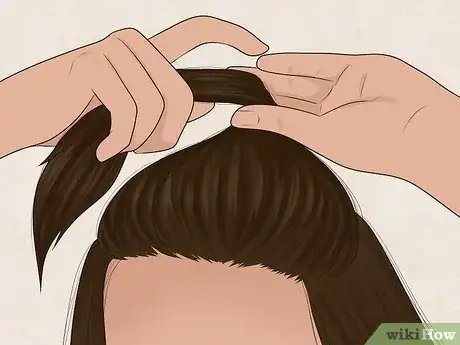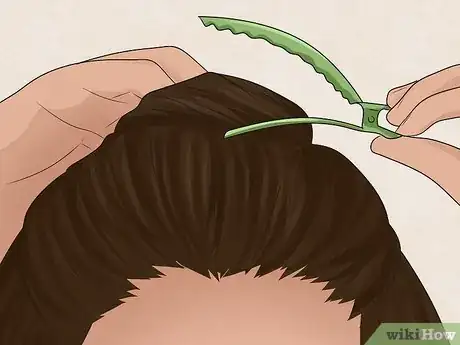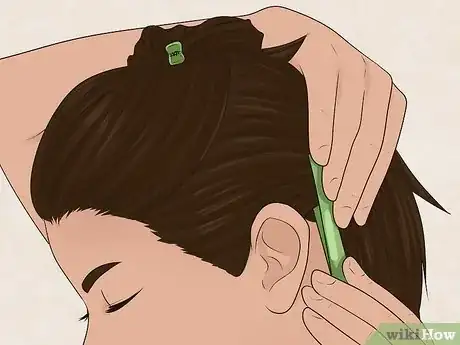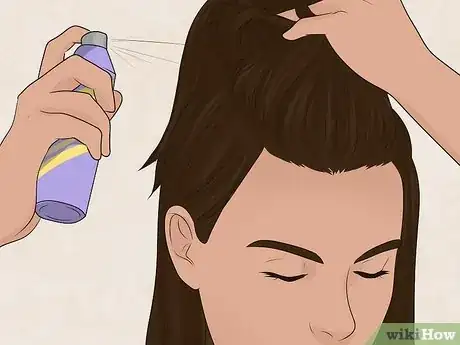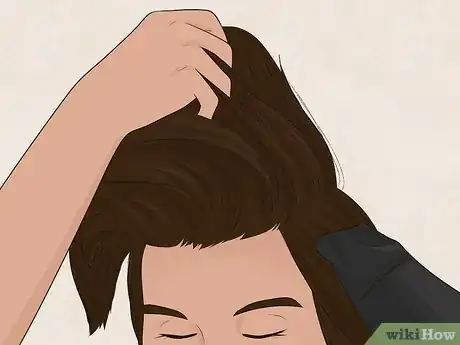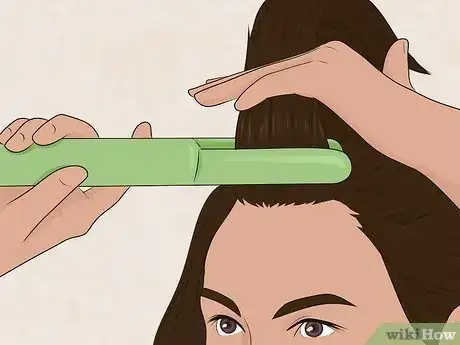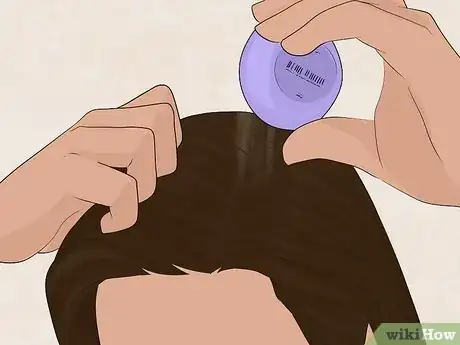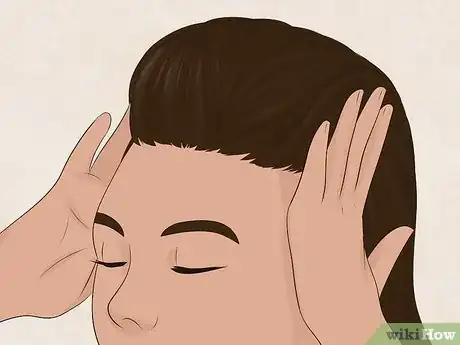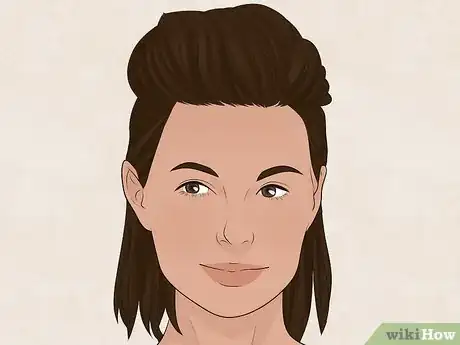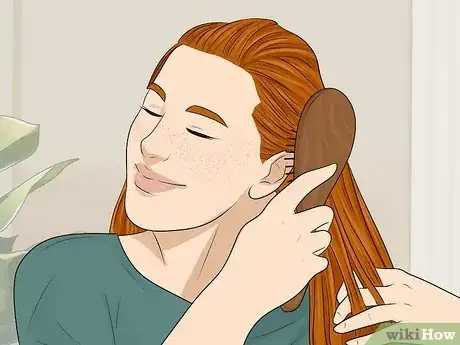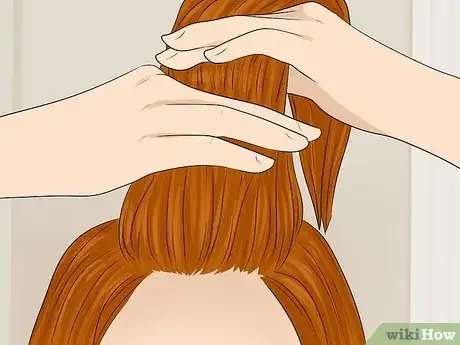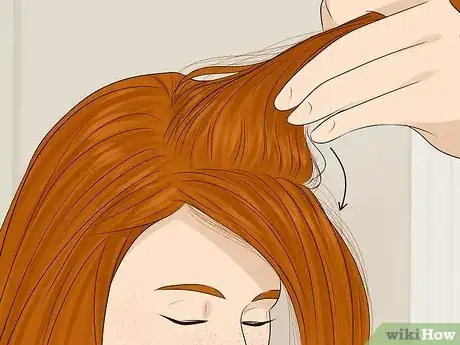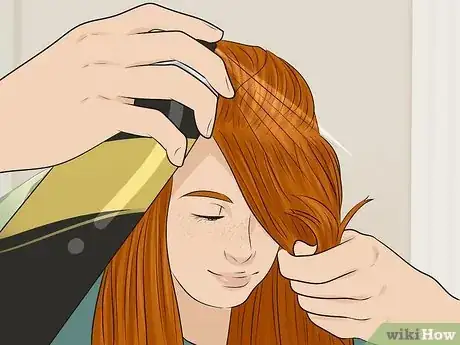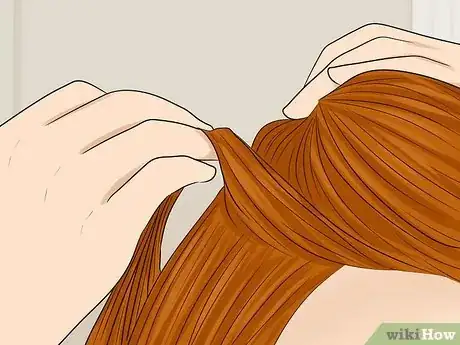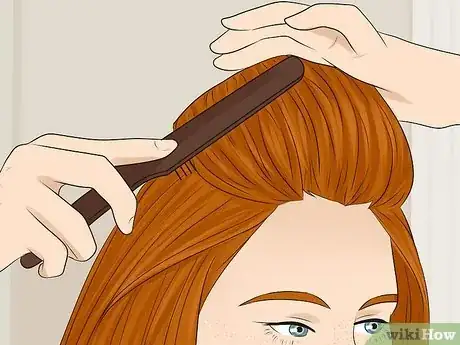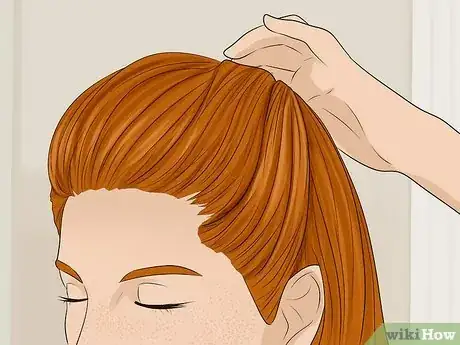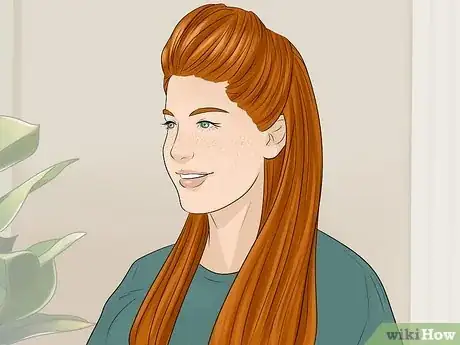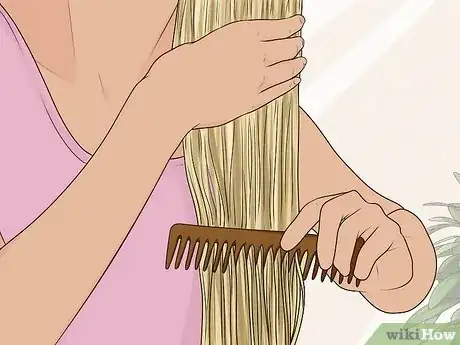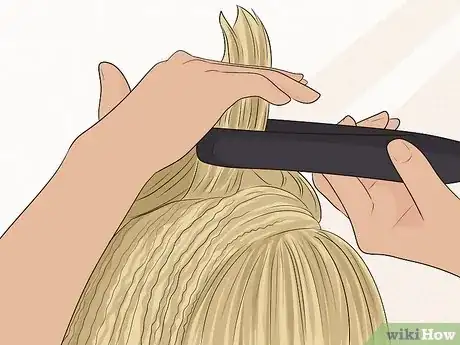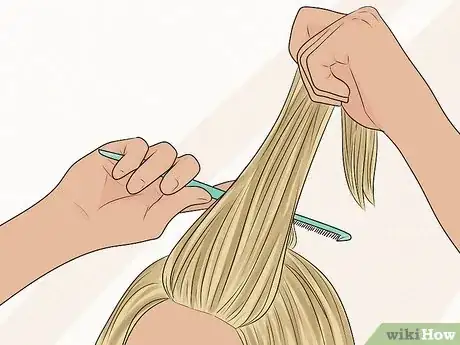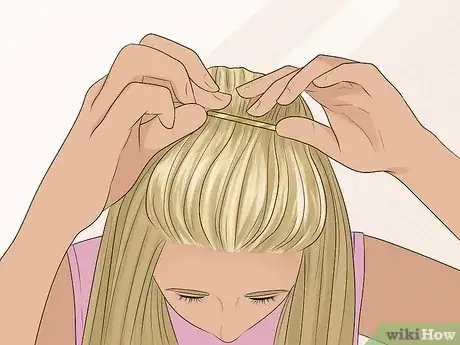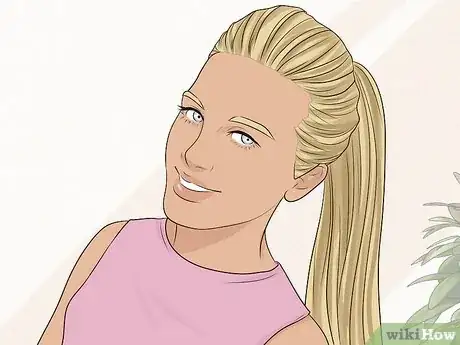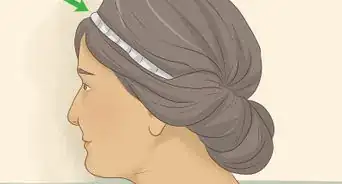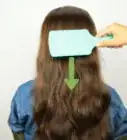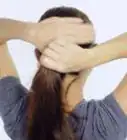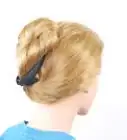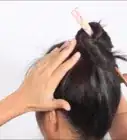This article was co-authored by Martin Nepton. Martin Nepton is a Professional Hair Stylist and Colorist at Bang Bang LA in Los Angeles, California. With over 11 years of experience, Martin specializes in helping clients express their Queer identity through hair. Martin offers personalized haircuts and color and style services with non-gender prices based on hair length. Martin holds a BA from the University of Québec at Montréal and is a Licensed Hair Stylist in California.
This article has been viewed 33,355 times.
A quiff is a trendy hairstyle that focuses on sweeping your hair back to create a bump. If you have very short hair, you can do a traditional quiff. If you have longer hair, however, you will need to use a slightly different method, otherwise the weight of your hair will weigh down the quiff. Once you get the hang of creating the quiff, you can combine the style with a chic ponytail for a twist.
Steps
Doing a Quiff on Short Hair
-
1Gather the hair at the top of your head. The section needs to start at your forehead and go back towards your crown. It needs to be the same width as your eyebrows at the front, and end in a U-shaped curve in the back, rather than a V-shaped point.[1]
- Use the handle of a rat-tail comb to create neat and even parts.
- This method works the best with jaw-length hair. You may also be able to do this method with an undercut or a side fade, however.
-
2Tie or clip off the top section off. You can twist it into a bun or secure it with a hair clip. Don't worry about being too precise or neat; you will be returning to this section shortly.[2]
- If you have an undercut or a fade, simply gather all the long hair at the top of your hair.
Advertisement -
3Clip the hair at the sides of your head out of the way. Gather the hair at your temples, just in front of your ears. Pull the hair behind your ears, and secure it with clips. The hair should run horizontally against the side of your head.[3]
- If you have an undercut or fade, you can skip this step; your hair is already short on the sides.
-
4Undo the top part of your hair and mist it with a texturizing spray. Be sure that you mist the top, sides, and underside, focusing on the roots. At this point, it would also be a good idea to apply a heat-protection spray.[4]
-
5Blow dry your hair at the roots to give it lift and volume.[5] Insert a flat or concentrator nozzle onto your hairdryer. Aim the nozzle at your roots and point it upwards towards your forehead. Blow dry the misted hair while lifting it upwards at the roots. You should see your quiff starting to take form.[6]
-
6Straighten the outer portions of the hair. Use the handle of a rat-tail comb to gather a thin section of hair from your front hairline, spanning from eyebrow to eyebrow. Hold the section straight above your head and straighten it upwards. Gently lay the section against the quiff.[7]
- If you don't have a hair straightener, you may be able to use a curling iron with a wide barrel.
- Repeat this step for the sides of the quiff; only gather a thin section from the side parts.
-
7Apply a texturizing powder or dry shampoo to the quiff. Shake the powder onto the top, front, and sides of the quiff. Lift parts of the quiff away, and shake the powder inside as well. Work the powder into the quiff with your fingers.[8] You can also try using a texturizing mousse for this step instead.
- If you have thick, coarse hair, you may not need to do this step at all.
-
8Shape the quiff, then set it with hairspray. Lightly mist the quiff with hairspray first. Push down on the hair at the back of your crown, then slide your hand forward, causing the hair to bunch up. Spray the hair with hairspray.[9]
- If you're having difficulty shaping the quiff, take a little bit of pomade into your hand, and apply it to your hair before you try shaping it again.
-
9Spray the sides of your hair, then remove the clips. Wait for the hairspray to set first before you remove the clips. If your hair doesn't hold, you can lightly mist it with more hairspray.[10]
- If you have an undercut or fade, you can skip this step. Your hair should be short enough on the sides to not need any support.
-
10Finish the look off with a light misting of finishing spray. Do any final touch ups, then mist your hair one last time. You are now ready to rock your style![11]
Doing a Quiff on Long Hair
-
1Brush back your hair. You can do this with a comb, a brush, or even your fingers. The goal is to gather your hair away from your front hairline and eliminate your part. This method works the best on hair that's at least shoulder-length. If you can pull your hair back into a half-up, half-down ponytail, you can do this method.
-
2Gather the hair at the top of your head. The section should span the width of your forehead, from eyebrow-to-brow. It should come to a point at the top-center of your head, about where your ears are. Have the section end in a straight, horizontal line or a soft curve, not a V-shaped point.[12]
- Don't gather all of the hair at the top of your head just yet; you'll be adding more hair to this section later.
- Use the handle of rat-tail comb to create neat, even parts.
-
3Backcomb the section you gathered, spray it, then backcomb it again. Use a downward C-motion and short strokes to do this. It would be easier to do this with a special backcombing brush, but you can use a regular comb instead as well. Spray the section with texturizing hairspray between each backcombing.[13]
- If you have curly hair, you can put your hair into hot rollers instead of backcombing. Roll your hair backwards and away from your face, and leave them in for 15 minutes.[14]
-
4Add the rest of the hair from your crown to the section. The section should now span towards the back of your crown, just where your skull begins to curve downward. Have the section end in a soft curve rather than a sharp point.[15]
- If you used hot rollers in the previous step, you can use them for this step as well.
-
5Spray and backcomb your hair one more time. Lightly mist the hair you just added to the section. Backcomb it using the same method as before. Spray it a second time, and backcomb it again.
-
6Blend the quiff in by adding in extra strands of hair into it. By this point, you may have a clear part between the quiff and the rest of your hair. This may look a little too stark for your hair length. Conceal it by taking thin strands of hair from below the part (where the quiff starts), backcombing them, and adding them to the quiff.[16]
-
7Gently smooth the quiff back. Glide your brush over the top and sides of your quiff, smoothing it down. Be careful not to press too hard down onto it, or your will lose the effect. You can use your backcombing brush or a boar-bristle brush for this, as long as you press lightly.[17]
-
8Gather the hair from your temples and pin it back. Take the hair from the side of your head, just in front of your ear. Pull it back behind your head and pin it in place with a bobby pin. Repeat this step for the other side of your head.[18] Make sure that the bobby pins match your hair color.
- You may be able to hide the bobby pins under other pieces of hair.
- You will be pinning your hair over the tail-end of the quiff. Be careful not to pull the quiff down.
-
9Make any final touches. At this point, you can get creative here. You can loosely curl your hair for a boho touch, or you can straighten it. You can also leave your hair as-is. Lightly mist you hair with hairspray, if needed, before heading out.
Doing a Quiff Ponytail
-
1Comb out your hair to ensure that it is tangle free. This style works the best with longer hair, but you can try it with shoulder length as well. If you can pull your hair up into a swishy ponytail, you can do this method.
- Consider straightening your hair first to get a sleeker, more traditional look.
-
2Section off the top part of your hair. Use the handle of a rat-tail comb to gather the top part of your hair. Have the section span from one eyebrow to the other, and reach all the way back to your ears. End the section in a soft curve rather than a point.[19]
- Pull the rest of your hair back into a low ponytail. You can secure it with a clip or a hair tie.
-
3Consider crimping the section you gathered. While it is possible to get a quiff without any crimping, this will really amp up the volume. Split you hair in half horizontally, and crimp only the back section—not the front. This way, the bumpy texture won't be visible in the end.[20]
- Apply a heat protectant spray to your hair before crimping it.
- Brush you hair out after crimping it. This will make it softer and fluffier.
-
4Backcomb your hair with a comb or backcombing brush. Start by backcombing the back portion of your gathered section. If you need more volume, you can divide the section up into thinner sections, and backcomb each one.[21]
- Spray the sections with texturizing hairspray to help them hold the added volume.
-
5Pin the section to your crown, forming a bump. Gently pull the hair against the top of your head, then push it forward a little, forming a bump. Insert bobby pins through the left and right sides, just behind the bump. The bump should only be on the front part of your head, between your front hairline and ears.[22]
- Use bobby pins that match your hair color.
-
6Carefully pull the rest of your hair back into a high ponytail. Be careful not to pull on the top part of your hair too much, otherwise you will move the quiff out of place. Secure the ponytail with a hair tie; try to use one that matches your hair color.[23]
-
7Set the style with a light misting of hairspray. For a fancier touch, take a thin strand of hair from the underside of the ponytail, and wrap it around the base, hiding the hair tie. Secure the strand with a bobby pin.[24]
Things You'll Need
Doing a Quiff on Short Hair
- Rat-tail comb
- Hair clips
- Hairspray
- Texturizing spray
- Heat protectant spray
- Dry shampoo or texturizing powder/mousse
- Hairdryer
- Flat, concentrator nozzle
- Hair straightener
Doing a Quiff on Long Hair
- Rat-tail comb or backcombing brush
- Hairspray
- Texturizing spray
- Bobby pins
Doing a Quiff Ponytail
- Rat-tail comb
- Crimper (optional but recommended)
- Hairspray
- Bobby pins
- Hair tie
References
- ↑ https://www.youtube.com/watch?v=oPH7fraV4do
- ↑ https://www.youtube.com/watch?v=oPH7fraV4do
- ↑ https://www.youtube.com/watch?v=oPH7fraV4do
- ↑ https://www.youtube.com/watch?v=oPH7fraV4do
- ↑ Martin Nepton. Professional Hair Stylist. Expert Interview. 17 November 2020.
- ↑ https://www.youtube.com/watch?v=oPH7fraV4do
- ↑ https://www.youtube.com/watch?v=oPH7fraV4do
- ↑ https://www.youtube.com/watch?v=oPH7fraV4do
- ↑ https://www.youtube.com/watch?v=oPH7fraV4do
- ↑ https://www.youtube.com/watch?v=oPH7fraV4do
- ↑ https://www.youtube.com/watch?v=oPH7fraV4do
- ↑ https://www.youtube.com/watch?v=-9UsopavO0w
- ↑ https://www.youtube.com/watch?v=-9UsopavO0w
- ↑ https://www.naturallycurly.com/curlreading/hairstyles/quiff-for-curly-hair/
- ↑ https://www.youtube.com/watch?v=-9UsopavO0w
- ↑ https://www.youtube.com/watch?v=-9UsopavO0w
- ↑ https://www.youtube.com/watch?v=-9UsopavO0w
- ↑ https://www.youtube.com/watch?v=-9UsopavO0w
- ↑ https://www.youtube.com/watch?v=-Vo-GO1lZPc
- ↑ https://www.youtube.com/watch?v=-Vo-GO1lZPc
- ↑ https://www.youtube.com/watch?v=-Vo-GO1lZPc
- ↑ https://www.youtube.com/watch?v=-Vo-GO1lZPc
- ↑ https://www.youtube.com/watch?v=-Vo-GO1lZPc
- ↑ https://www.youtube.com/watch?v=z2YM5O-xE0s
- ↑ https://www.naturallycurly.com/curlreading/hairstyles/quiff-for-curly-hair/
- ↑ https://www.naturallycurly.com/curlreading/hairstyles/quiff-for-curly-hair/
